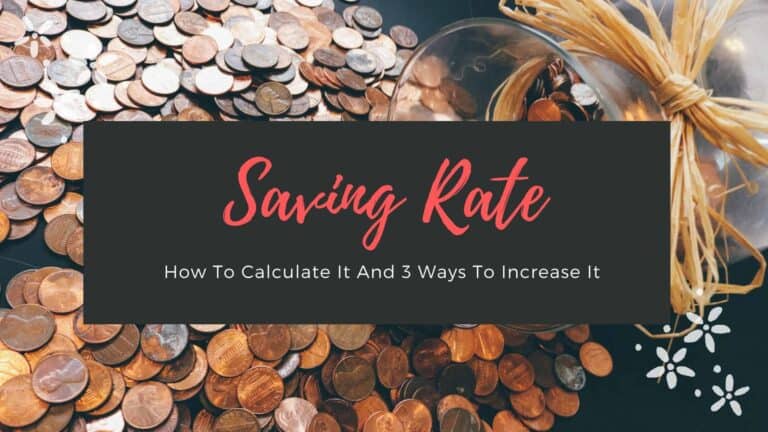Does the 4% Safe Withdrawal Rate Rule of Retirement Still Work?

What is the optimal strategy for spending your hard-earned retirement savings? We know the need to make prudent decisions when deciding how to invest, but spending money in retirement feels scary.
One of the great fears – mainly as Americans live longer – is that we will somehow outlive our money. Such an experience has resulted in many efforts to preserve retirement income and ensure that our retirement savings last as long as possible. One of the critical metrics of personal finance in retirement is the 4% retirement rule. This rule can be a good guideline. However, it has some severe drawbacks or alternatives that you must consider.
What Is the 4% Safe Withdrawal Rate Retirement Rule
The 4% retirement rule or the safe withdrawal rate rule is a guideline for how much money an individual should withdraw yearly as retirement income from their investment portfolio without running out of money.
The 4 % rule is relatively simple. In your first year of retirement, you withdraw 4% of all your investments, which is the money you live off of in year one. From there, you draw 4% every year while adjusting for inflation.
The 4% safe withdrawal rate is based on historical data and provides a starting point for retirees to adjust their withdrawals. While it serves as a helpful guideline, it’s important to remember that retirement planning is dynamic and requires continuous evaluation and adjustments.
History of the 4% Rule
Financial advisor William Bengen invented the rule of 4 in 1994, using historical data on stock and bond returns over 50 years from 1926 – 1976. He used the market performance data with a 60/40 portfolio (60 percent equities, 40 percent bonds) to gauge how a person who retired during that period would have faired in a period with massive stock market rises and significant crashes. Bengen believed it was relatively reflective of the market volatility that the average retiree would face.
The implementation of the 4 % rule has been criticized by none less than Bengen himself, who noted that the rule has likely been interpreted as a typical case rather than a worst-case scenario. Bengen has said that historical data indicates that a 5% withdrawal rate is probably more appropriate for retirement assets and is likely supported by market conditions.
The 4 % rule can be interpreted in different ways. For example, individuals likely to live longer or take early retirement will need their retirement assets to last longer, thus meaning that 4% may be too much of a withdrawal rate for their retirement withdrawals to handle.
Assumptions of the 4% Rule
The 4 % rule can be an excellent way of achieving a steady income stream in your retirement, ensuring you have enough money to live for the rest of your life. However, like any other retirement spending plan, it is meant to serve as a guideline for managing retirement portfolios, and it is not necessarily a hard-and-fast rule.
When considering the 4 % rule for your portfolio, remember that it was developed with certain assumptions in mind. This includes:
- Actual investment results will support 4 % rule withdrawals. If investment returns regularly fail to meet expectations, withdrawing 4% annually may ultimately drop your actual investment results to dangerously low levels.
- Increases in certain non-discretionary costs – like living or medical expenses – devastate your finances. If your payments are too high, you may need more than 4% to meet your income needs. This is particularly the case for people with exceptionally high medical expenses.
- You have a healthy mix of asset classes. It means you own a good mix of stocks, bonds, and international stocks. A diverse asset allocation mix will ensure you can weather any down market. Bengen did the original research on a 60/40 stock-bond portfolio and did not include alternative investments.
- You appropriately manage inflation-adjusted withdrawals. Inflation changes annually, and you must consider inflation’s role when making withdrawals.
- You regularly monitor your investment portfolio for changing market conditions, performance, and fees. As much as most people would like to “set it and forget it” regarding their retirement savings, the truth is that market conditions change regularly. The 4 % rule generally assumes active and responsible management of your retirement savings. You must watch the stock and bond returns and rebalance asset allocation to the original targets to protect your retirement funds.
- Historical data is critical, but as the expression goes, past performance is not necessarily indicative of future results. The 4 % rule is a retirement planning concept that is built around the idea of a balanced portfolio of assets. You must constantly monitor various investment outcomes to be able to live off of a steady income.
Pros of the 4% Rule
Simplicity To Calculate Your Nest Egg
The 4 % rule can be an excellent guideline for appropriately managing your retirement spending plan. It provides a starting point to base the size of your retirement nest egg at 25 times your expected annual expenses.
Inflation Adjusted Withdrawals
Proper adherence to a regular withdrawal schedule of a certain percentage – rather than a fixed withdrawal amount – can ensure that you will always have money in your retirement account based on the inflation rate.
Consequently, as inflation increases your living expenses, your withdrawal amounts increase, keeping pace with inflation.
Ease of Calculation
The 4 % rule is simple. There is nothing complicated about it. Calculate your total assets. Withdraw 4%. Stick to that number for the entire year. Repeat for next year, adjusting for inflation. As such, it is an easy rule to understand and adhere to.
A steady withdrawal rate – in this case, 4% – ensures you have predictability and stability of your retirement income. You can adjust this rate upwards or downwards as needed, but if you are on a fixed income, you’ll be able to determine just what your withdrawal will be.
Backed by Historical Data
The 4 % rule is not just a made-up rule of thumb. It was invented and empirically designed based on the historical data of past stock performance. You can understand that it isn’t simply a tool developed to sell you more stocks or delay your retirement. Instead, it was designed to serve as a rough guideline for the best way to safely draw down your retirement funds that will reflect actual investment results.
Cons of the 4% Rule and Common Mistakes To Avoid
The 4% rule is a widely-used guideline in retirement finance, but it has risks. While this rule generally states that retirees should withdraw no more than 4% of their savings annually to avoid running out of money, it’s important to remember that this is just a generalization.
Factors such as inflation and varying rates of return can affect the long-term sustainability of this strategy. Additionally, many retirees make common mistakes, such as underestimating their life expectancy or failing to adjust their withdrawal rate based on market performance. To truly safeguard your retirement savings, it’s essential to understand these risks and avoid these common missteps.
Based on Historical Returns
Investors have assumed that since the 4% rule worked during the specific 1926 to 1992 time period, it will also work in other periods. However, this is a huge assumption to make.
Past performance is not indicative of future performance. Relying on past performance to predict future returns can lead to overconfidence in your chances of success, especially as we consider preparing for an upcoming recession.
As such, the 4 % rule may now need to be updated, and there is not necessarily an indication that market conditions will return to a place where that rule can be successful again.
Investment Costs Not Considered
The 4% rule did not consider the impact of investment fees on expected returns, which can also affect its success.
Of course, with the advent of low-cost index funds, the fees to invest in stocks have substantially decreased.
However, mutual funds or hedge funds still exist, which charge exorbitant fees. Factoring in investment fees when calculating your withdrawal rate might be prudent.
M1Finance lets you invest at as low as $100 and has no fees. You can read my M1Finance Review for more information.
Taxes Not Included
When managing your finances for retirement, taxes can take a big bite out of your savings. Luckily, there are ways to reduce the taxes you pay when you’re withdrawing funds using the 4% rule. One strategy is diversifying your retirement accounts between traditional or Roth 401(k).
With a Roth IRA, you pay taxes on your contributions now but enjoy tax-free withdrawals in retirement. A Roth conversion ladder approach could be one of the options.
Another approach is to plan for tax-efficient withdrawal strategies, such as delaying Social Security until age 70 or withdrawing from taxable accounts first. These tips can help stretch your retirement savings and minimize taxes.
Only Domestic Assets Included
The 4% rule was based solely on U.S. assets. A diversified portfolio would include international stocks, and in the past decade, the performance of foreign stocks has lagged the U.S. markets.
The 4% safe withdrawal rate studies were based on U.S. stock performance, but similar results have yet to be replicated in other markets worldwide.
Dr. Wade Pfau studied sustainable withdrawal rates using 109 years of financial market data for 17 developed countries. In a paper published for the Journal of Financial Planning, he concluded, “From an international perspective, a 4 percent real withdrawal rate is surprisingly risky. Even with some overly optimistic assumptions, it would have only provided “safety” in 4 of the 17 countries.”
The U.S. has advantages due to the reserve currency status, but questions are being raised if this unfair advantage would continue.
Current CAPE Ratio Higher
When Bengen carried out this study, the CAPE ratio was lower than the current one. Some experts believe the current higher CAPE valuations would result in below-average performance in the future.
Rigid Rule
The 4% rule is based on increasing your annual spending by the inflation rate instead of depending on your portfolio’s performance. This can be difficult for some investors because it doesn’t account for years when your portfolio may underperform, and you risk depleting your nest egg.
Moreover, this rule assumes that your spending remains constant every year, which is not usually the case for most people in retirement. Retirement expenses fluctuate yearly, and the amount spent may change throughout retirement.
For example, retirement spending usually tends to follow a smile curve. Expenses increase in the first few years following retirement as most individuals embark on expensive hobbies like travel, golf, or buying a vacation home. Expenses gradually reduce as retirement continues and only spike up in the last few years due to increasing healthcare costs.
Health Savings Accounts, which are triple-tax advantaged, offer an easy way to save money for healthcare costs.
If your employer-sponsored account has additional fees or charges extra to invest, you can roll over your prior year’s funds to Lively or Fidelity. Or if you have a High Deductible Health Plan, consider Lively to save taxes on your HSA.
Lively HSA is free and has no hidden fees. Also, Lively won’t charge you any fees to roll over or transfer your HSA to them. You can move your full or partial balance directly to Lively from your existing provider. Lively will contact your previous provider and handle the transfer on your behalf.
Increasing Life Expectancy
While this isn’t a “problem” in the traditional sense, it does create real issues. It is now more possible than ever that an adult will run out of money and not have enough money to get the full benefit of their retirement savings and safely withdraw 4% every year.
The Sequence of Returns Risk
Although the 4% mathematically should work based on historical market performance, there is an element of luck concerning the sequence of returns risk.
The timing of one’s retirement is critical to the success of the 4 % rule. If someone retires during a market recession or inflation increases to stop an investment portfolio from growing, a retiree can face major financial challenges.
In these circumstances, the 4 % rule may not work, as it may mean someone is taking out too much money. For example, in a scenario where stock and bond returns aren’t meeting expected results, you may find that the 4 % rule means you are simply withdrawing too much money.
Alternatively, you may shift your funds to a more conservative asset allocation. While moving the asset mix to something like fixed-income securities can protect your nest egg and limit risk, it can also reduce growth. As a result, you may find yourself in a situation where the 4 % rule doesn’t apply.
Doesn’t Account for Emergency Spending
Withdrawing more than 4% can be devastating. That’s because removing more can alter the growth calculations due to a loss of the principal invested. So, if you have a significant expense and need to dip into your nest egg, you may hurt yourself.
Changes to the 4% rule for FIRE investors
The rule of withdrawing 4% during retirement is designed for 30 years. However, your retirement may last over 50 years if you are a FIRE investor. This is a significant difference, and it’s crucial to consider your retirement length when setting your financial goals. We recommend calculating your withdrawal rate based on a reasonable retirement period.
Fat Fire
Fat FIRE ensures you have a significant net worth at retirement, not just for your living expenses but to live lavishly.
The safe withdrawal rate for Fat Fire should ideally be lower at 3.33% or even 3% to account for a higher margin of safety and also pass on generational wealth to your survivors using a revocable living trust.
Trust & Will provides state-specific trusts for the protection and transfer of your most important financial assets. You can also nominate legal guardians for your children to make sure they are looked after by someone you know and trust, in case something happens to you.
Regular Fire
Regular Fire typically advocates a withdrawal rate of 4%, but considering the challenges with the 4% rule, it might be prudent to lower it.
Coast Fire
The Coast FIRE method ensures you have invested enough to stop contributing and live a comfortable retired life. Ideally, most individuals pursuing Coast FIRE might not need modifications to the 4% rule.
When someone tries to achieve Coast FIRE, they must realize that the FIRE method eliminates the part about retiring early. It is about retiring with peace of mind, which is most important to many people.
Barista FIRE
Barista FIRE is named after baristas at Starbucks, which recently announced that they would offer health insurance to all employees who average 20 hours per week.
Ideally, most individuals pursuing Barista FIRE would have settled into low-stress retirement jobs. They might not need modifications to the 4% rule since they would be retiring at the average retirement age.
Alternatives to the 4% Rule
Retirement can be a daunting and confusing time, especially when managing finances. The commonly used 4% rule may not be the best option for everyone.
Fortunately, there are many alternatives available for retirees planning their financial future. Some popular options include the bucket strategy, bond laddering, and time-segmented approaches. Each approach offers unique benefits and drawbacks, so it’s essential to carefully consider which aligns best with your individual goals and circumstances.
Another alternative is to try and guesstimate your withdrawals based on how long you expect to live. This can be a morbid exercise, so you can use actuarial tables published by the IRS to guide this decision. In conjunction with a financial planner, you can use these tables to determine what withdrawal rate would allow you to live the lifestyle you’d like within the confines of how long you expect to survive.
Investors who desire predictability in their retirement may prefer investments for monthly income to pay their bills.
Some may shift their portfolio to include more dividend stocks, such as the dividend aristocrats, instead of investing in the S&P 500.
Others may opt for real estate investments in the form of turnkey properties or real estate notes.
Roofstock is an online marketplace for tenant-occupied single-family homes—many of which are pre-inspected, come with a tenant in place, and are generating cash flow. Some even offer vacancy protection or a 30-day money-back guarantee.
You can also make significant shifts in your investments as you get older. You can guarantee a steady income stream by shifting from stocks to annuities. Annuities are guaranteed, but they are not without their drawbacks.
Most annuities do not make distributions that reflect the rising inflation rate, so you may find yourself in a position where your money no longer goes as far as it once did. Furthermore, annuities won’t grow the way investment in stocks may.
Finally, annuities will generate less income if you structure them so that they are inherited by a loved one, like a spouse. Guaranteeing a surviving partner’s financial future takes a healthy bite out of your nest egg.
Ultimately, by exploring these various alternatives, retirees can create a strategy that maximizes their financial security and enjoyment of retirement.
Is the 4% Rule Still Valid
As you can see, the 4% rule can benefit retirees. It is simple to understand and provides a steady, predictable income stream while answering the question of when can I retire.. However, it is not, by any means, the only potential withdrawal method that retirees can adhere to, and there are many other possibilities.
First and foremost, you can use the 4 % rule with a different number. Some economists say 3.3% is better. Others argue you can make more liberal withdrawals, removing more than 5% when retiring. There isn’t a set answer for alternative withdrawal rates, and you can use various free retirement calculators to plan.
Personal Capital is a free tool with many different features including a retirement planner which lets you model out different scenarios including large spending events in retirement such as buying a cabin or paying for your kids education. Check out my step-by-step guide to signing up and the in-depth Personal Capital review of all the features.
A better bet is to speak with your financial planner to determine if the 4 %rule works for you. Your planner can help you develop a better alternative if it doesn’t.
Retirement spending and asset allocations are deeply complicated, complex, and personal decisions. There are many factors to consider: Are you in a bear market? What are the economic conditions or market conditions you are facing? How steady of an income will you be able to live on? What will your annual spending be? What is your risk tolerance?
Answering these questions alone may be difficult, and you may benefit extensively from consulting with a financial planning professional. A financial planner or financial adviser can help guide your investments, confirm that your retirement planning is on track, and prevent you from running out of money. Just remember: The 4 % rule is a rule of thumb. It is not a strict and set rule. All financial plans are individualized, and you must ensure that your withdrawal rates suit your financial goals.

John Dealbreuin came from a third world country to the US with only $1,000 not knowing anyone; guided by an immigrant dream. In 12 years, he achieved his retirement number.
He started Financial Freedom Countdown to help everyone think differently about their financial challenges and live their best lives. John resides in the San Francisco Bay Area enjoying nature trails and weight training.
Here are his recommended tools
Personal Capital: This is a free tool John uses to track his net worth on a regular basis and as a retirement planner. It also alerts him wrt hidden fees and has a budget tracker included.
Platforms like Yieldstreet provide investment options in art, legal, real estate, structured notes, venture capital, etc. They also have fixed-income portfolios spread across multiple asset classes with a single investment with low minimums of $10,000.





